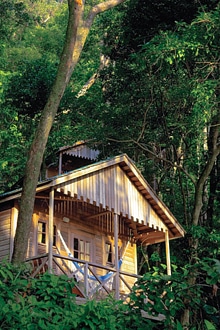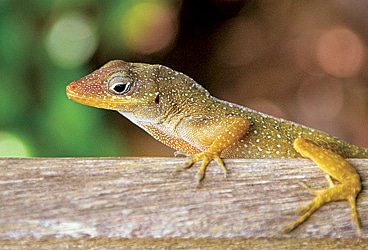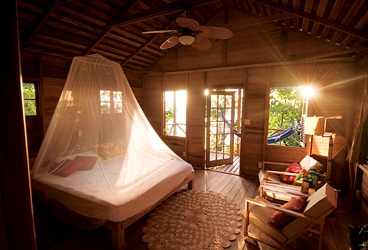Blue List: Green Resorts
What Are Green Resorts?As more resorts tout themselves as environmentally friendly, sometimes it's hard to tell what's green and what's "greenwash." Look for resorts that employ locals, buy locally, support community projects and show respect for local traditions, as well as minimizing their effects on the environment by using renewable energy, conserving water, recycling resources and protecting the natural habitat. When in doubt, ask. A truly green resort will be able to articulate clearly how they're making a difference — and you might be surprised by how big a positive difference their work can make.
Dominica's Jungle Bay Resort & Spa
The rolling Atlantic Ocean reflects the late-after- noon light. Sunshine pierces the white cedars, gommiers and palms. Blue-headed hummingbirds zip between the trees, trilling to each other. A small lizard speeds up the balcony's frame, an insect in sight. Then a Lesser Antillean bullfinch, with its ruby-red throat, swooshes past on the way to its nest. And I am in my own nest in the trees. Right now I belong in this jungle, just as much as the birds and the lizards do.
Before my husband, Mike, and I came to Jungle Bay Resort & Spa on the "Nature Island" of Dominica, I knew that I wouldn't have a fancy flatscreen television in my room. But I didn't realize I'd have a superior substitute in its place.
At Jungle Bay, ecology itself is an amenity. The resort has worked hard to minimize its impact on the environment by constructing its 35 cottages, restaurant and main lodge within the native forest rather than clearcutting the land and importing manicured landscapes. Left intact, the environment impacts me.
I soon find I have superior stand-ins for other "missing" amenities. The cottage's raised, open-air design catches ocean breezes to keep me cool. The hum of crickets and the white noise of waves sing me to sleep rather than the mechanical buzz of an air-conditioner. An energy-efficient outdoor shower uses water from a spring-fed stream — I feel like I'm literally immersed in the rainforest. In place of trendy minimalist décor, my cottage features white cedar furniture made by local carpenters. The effect is rough-hewn and tropical, like Dominica itself.
That evening in the resort's Pavilion Restaurant, I get another taste of Dominica, but not one I expected. I've just finished a meal made almost entirely from local, organic ingredients: a tangy cream-of-tomato soup, spinach salad, spicy creole chicken and plantain mash, plus coconut ice cream on rum cake. I'm stuffed and ready for bed.

But before I can get up, a group of musicians and dancers walks into the restaurant. An ancient accordion player walks slowly to his chair. Younger musicians carry a drum, a long horn, a tambourine and a rattle. One dancer explains that they are the Petite Savanne Cultural Group from a nearby village, here to perform some Dominican dances.
The music, called jing ping, sounds a bit like Louisiana Cajun with its quick pulse and jangle of instruments. The women flap the sides of their red swishy skirts like wings. The men's feet patter everywhere at once. When the music stops, a young man shows us the steps the group just performed. When the music starts, we bump into the other couples, laughing. I forget I wanted to go to bed. The pros perform another dance, then ask the audience to learn the moves.
"It's very interactive," says Sam Raphael when I meet him at the bar after the dance. Born on Dominica, Sam owns Jungle Bay with his wife, Glenda. He has a smile so relaxed it looks like it's lounging in a hammock. "The resort is just an amenity to enjoy the attraction, which is Dominica — the naked Dominica," he says.
The island reveals more of itself the next day, when we tour a few small businesses in Petite Savanne. In cushy seats on a flatbed, we snake down a curvy black road past hills the color of new leaves, and pastel-painted houses with old men sitting on the porches. They nod hello as we drive by.
Jungle Bay cultivates strong relationships with the people of Petite Savanne. By employing locals, buying from the region's farmers and fishermen and supporting community projects, the resort is helping to turn one of Dominica's most disadvantaged areas into one of the most prosperous. According to Sam, "There is no psychological boundary between Jungle Bay and the surrounding villages. We've become part of the community."
I see what he means near the end of our tour. After stops at a family-run rum distillery and a bay-oil factory, we pull up in front of a pale peach house. Our guide, Stevenson, explains that this is his home. He introduces us to his son and shows us his family's chickens and pigs and his garden. Then Stevenson and his son knock down mangoes, one for each of us, from a tree on his property.

I'm struck by Stevenson's hospitality. He's shown us his town; now he's showing us his own home and sharing his family's mangoes. Then I realize I've felt this welcomed the whole time I've been a guest of Jungle Bay. The resort's staff treats me like I'm part of the community, too.
I lean out from the balcony of our cottage on our last night and try to record the sounds of the jungle on my MP3 player. I want to take it all back with me — the waves, the crickets, the lizards, the hummingbirds and bullfinches, the rum punch, the jing ping dance, the scent of bay oil, the forest's leafy layers of green. Earlier Sam said to me, "When you're in our cottages, you should know where you are. You should know you're in Dominica."
With the world trending toward homogeneity, such a strong sense of place is getting harder to find. This luxury — the rich, authentic experience of Dominica — is mine to keep. I stop recording and just listen, letting the jungle fill me with its peaceful music. junglebaydominica.com
Green Resorts: More Winners In addition to our featured trip detailed above, ISLANDS recommends these trips from our 2009 Blue List, which also represent the best in sustainable travel.
Deer Run Bed & Breakfast, Big Pine Key Jen and Harry run this Keys B&B, renovated with salvaged and recycled materials. They serve organic, locally grown and fairly traded vegetarian menu items and use bamboo-fiber sheets. All proceeds from the inn's honor bar benefit local animal charities. deerrunfloridabb.com
Milia Mountain Retreat, CreteSet right into the mountain, Milia's 16 rooms incorporate local chestnut wood and stone. Carefully matched to the characteristics of the region, the retreat could be easy to miss. Nothing goes to waste here. Fruits and vegetables not used in the kitchen go to the animals, which in turn provide the milk, meat, wool and manure. milia.gr
Turtle Island Resort, Fiji Turtle Island's beachside cottages are built by local craftsmen using natural products from the island. Through an intensive reforestation program, over 500,000 trees have been planted here in the past 30 years. Join resident marine biologists as they survey reefs and coral life. Inscribe a message (in biofriendly paint) on a rescued turtle's shell, rendering it almost worthless to poachers. Enjoy organic produce from the gardens. turtlefiji.com
Paradise Bay Eco Escape, South Long Island, AustraliaSurround yourself with local art at the Paradise Bay Eco Escape. Demonstrating the owner's passion for aboriginal art, the works on display were purchased directly through the artists or from a reputable local gallery to sustain the local culture and economy. The property was also designed with minimal impact on the environment and uses 100 percent alternative energy sources for power. paradisebay.com.au
Ibo Island Lodge, MozambiqueStay in the heart of the Quirimbas National Park in an old Portuguese colonial mansion, dating back over a hundred years. Supplies for the lodge arrive in traditional sailing dhows. Gutters and cisterns capture enough water to supply some areas of the facility. The lodge, which also leads the Ibo Islands Silversmiths Project, founded a community garden to reduce produce imports, and hires locally trained guides to take guests on island tours. iboisland.com
